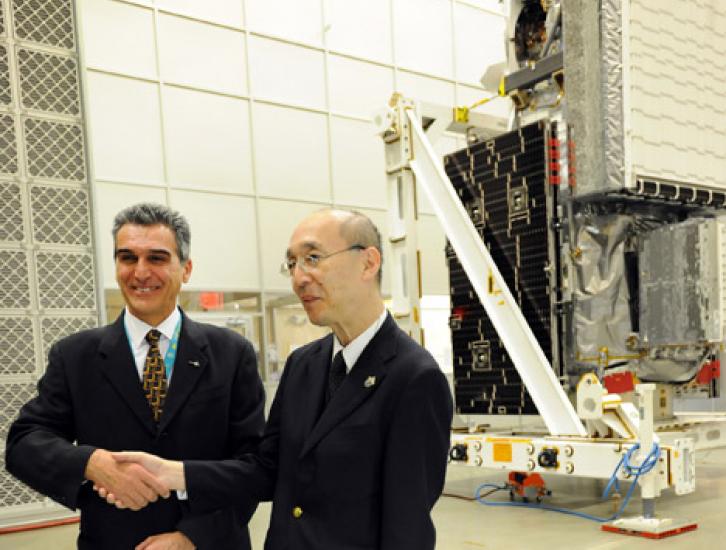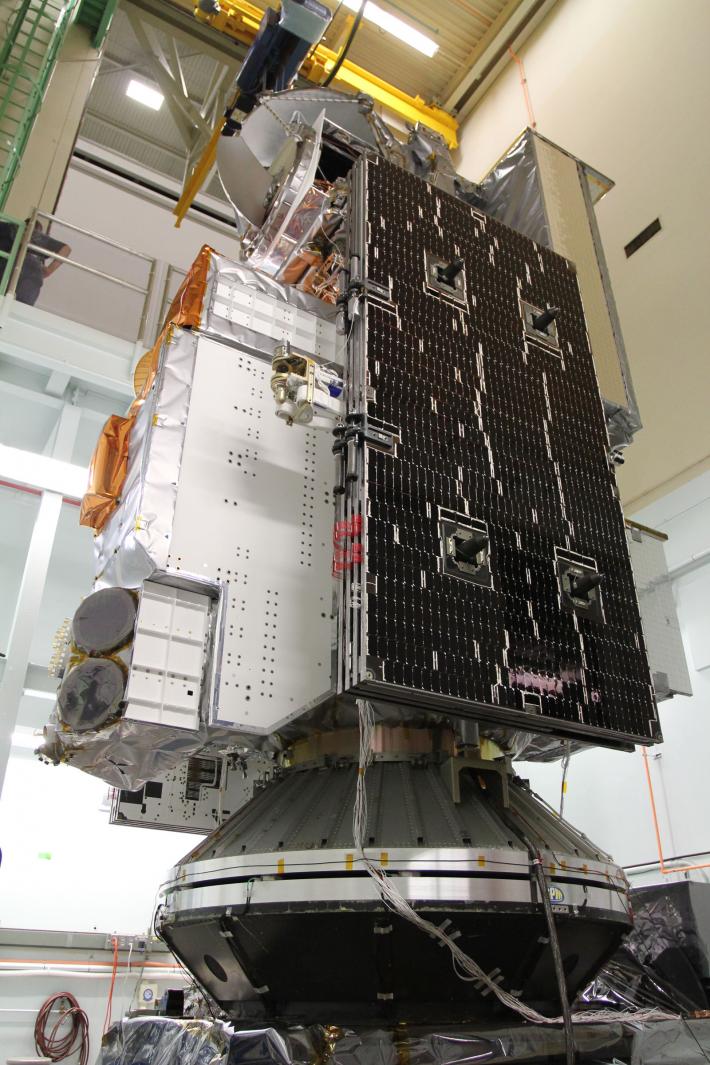
NASA's GPM Satellite Begins Journey
For the past three years, the Global Precipitation Measurement (GPM) Core Observatory has gone from components and assembly drawings to a fully functioning satellite at NASA's Goddard Space Flight Center in Greenbelt, Md. The satellite has now arrived in Japan, where it will lift off in early 2014.
The journey to the launch pad has been a long and painstaking process. It began with the most basic assembly of the satellite's frame and electrical system, continued through the integration of its two science instruments, and has now culminated in the completion of a dizzying array of environmental tests to check and recheck that GPM Core Observatory will survive its new home in orbit.
"The GPM Observatory is about 3,900 kilograms (8,598 pounds)of spacecraft, fully loaded," said GPM Project Manager Art Azarbarzin at Goddard. "It's a very large spacecraft. It's a very large wing span." The satellite left the nest in a large white shipping container, its two solar arrays tucked neatly into its sides.Fully extended, they will spread about 12 meters (13.1 yards) in either direction. The GPM Core Observatory is the largest spacecraft ever built at Goddard, and managing its sheer size was one thing that always had to be kept in mind, said Azarbarzin.
The Core Observatory is part of an international partnership, led by NASA and the Japan Aerospace Exploration Agency, or JAXA. It will combine measurements from multiple satellites to see where and how much it's raining or snowing over 90 percent of the Earth every three hours. Precipitation affects everyone around the world, providing drinking water and freshwater for crops, and driving weather and storms that can cause hurricanes, landslides, and floods. Rain and snow are also part of the larger climate system for the globe.
In order to collect data on the tiny water droplets and ice particles that compose precipitation, the GPM Core Observatory has two state-of-the-art instruments – the GPM Microwave Imager or GMI and Dual-frequency Precipitation Radar or DPR.These instruments will observe more frequencies and capture a wider range of precipitation than has been done by one satellite before, from big fat drops in the tropics to drizzle or snow common in higher latitudes.
 The Global Precipitation Measurement Core Observatory, shown here in NASA Goddard's Integration and Test Facility, had to undergo many tests to ensure it will survive the harsh space environment. Image Credit: NASA
The Global Precipitation Measurement Core Observatory, shown here in NASA Goddard's Integration and Test Facility, had to undergo many tests to ensure it will survive the harsh space environment. Image Credit: NASAComing Together
The Goddard team began integrating components of the satellite in late 2010, beginning with the main spacecraft bus, or body, that contains the propulsion, navigation, power, communications, and data handling systems. In early 2012, the two science instruments arrived. Ball Aerospace Inc. of Boulder, Colo.,delivered the GMI, JAXA delivered the DPR, and the Goddard team integrated the all component pieces into a functioning satellite.
"It was very exciting to see the Observatory coming together every day," said Candace Carlisle, GPM's deputy project manager at Goddard.
From December 2012 through September 2013, the entire Observatory went through its environmental test program in Goddard's Integration and Test Facility to get the spacecraft ready for the ride to orbit and its life in space.
"The test program for the Observatory is pretty rigorous. And that's because when we're in space we only have one shot at it," said Azarbarzin. The antenna for the communications system, the antenna for the GPM Microwave Imager instrument, and the two solar panels all have to unfold perfectly, without any help, and then the whole satellite has survive its three-year mission life in the extremely harsh space environment.
There's a Test For That
Two hundred and fifty miles above Earth's surface the last gasp of the atmosphere blends into outer space. The region is part of the bottom edge of low Earth orbit, where a single molecule might only encounter a few other molecules in the course of an hour. It's where the rules we live by on Earth change. Earth-observing satellites and the International Space Station, also in low Earth orbit, travel in a constant free-fall around the planet, experiencing floating microgravity and bouncing between high and low temperatures while moving in and out of the sunlight in the course of a 93-minute orbit.
Survival in these harsh conditions is only slightly less difficult for machines than for humans. The electronics and the equipment to regulate temperature have to protect the electronics from the extreme hot and extreme cold.To prepare, the GPM Core Observatory entered the Thermal Vacuum chamber, a giant 12.2 meter (40-foot) chamber that looks like it came out of a gothic horror novel. The spacecraft was hoisted by crane and carefully lowered into the chamber, where all the air was pumped out. It spent a month running tests for four cycles of hot (104F / 40 C) and cold (14F / -10 C) extremes.
After thermal vacuum testing, the Core Observatory returned to the clean room where it went through the first of two tests to ensure the electronic systems on the spacecraft would not interfere or cause problems with each other. The engineering team built its own electromagnetic interference, or EMI, testing chamber, called a "GRUBEE," in the clean room to test out the spacecraft systems.
"We built the GRUBEE because we didn't have enough height in Goddard's EMI chamber to fully deploy the high gain antenna," said Carlisle. But for the second test, the spacecraft's size didn't get in the way. With the high gain antenna stowed in launch position, the spacecraft went through its paces in Goddard's EMI chamber to check that its systems, which would be up and running during launch, wouldn't experience interference from outside sources, each other, or cause interference with the systems on the rocket taking it into space.
Then there were tests for the shaking and shock. The GPM Core Observatory will blast off on top of the Japanese H-IIA rocket, launching from Tanegashima Island, Japan, in early 2014. Encapsulated in the tip, or faring, of the rocket, the satellite will rattle and shake to the roar of a hearing-destroying 120 decibels of sound. Six minutes after launch the faring will fall away and then nine minutes later, the spacecraft will separate from the rocket with controlled explosions that will release the connecting bolts. The separation gives the spacecraft a jolt, called separation shock, as it flies free.
On Earth, the GPM Core Observatory went through a trial version of each physical ordeal. A giant shaker table rapidly moved the spacecraft back and forth in three vibration tests, one each for forward and back, side to side, and up and down. Next it entered the acoustic chamber where a horn nearly the size of the spacecraft blew 120 decibels of simulated rocket noise.Finally, to simulate the separation shock, the Core Observatory returned to the clean room where it was mated to a test version of the rocket payload adapter and given a jolt.
The final tests for the GPM Core Observatory were ones that were repeated several times throughout the last year: deploying all of the spacecraft's moving parts and then running the satellite through a comprehensive test of all its systems. "We re-ran the comprehensive performance test yet again to make sure that we matched all of the performance we had before we went into environmental [testing]," said Carlisle. Only then was the satellite ready to ship.
It Takes a Global Village to Build a Satellite
Building a one-of-a-kind spacecraft from scratch is a huge endeavor. "Here at Goddard we have about 300 people working on GPM," said Carlisle. That includes the electrical and mechanical technicians and the engineering teams for each subsystem. "That, in addition to a number of people at the Japan Aerospace Exploration Agency who worked on the DPR instrument and at Ball Aerospace who worked on the GMI instrument. That also does not count our science team, who worked to build the algorithms and will be developing the science products after GPM launches," she said.
"It's a very dedicated and hardworking team," said Azarbarzin. He and the Goddard team are currently getting ready for the next phase of GPM. Once the satellite arrives at the launch site on Tanegashima Island, Japan, the team will conduct a final round of performance tests before the GPM Core Observatory takes its berth on the rocket.

